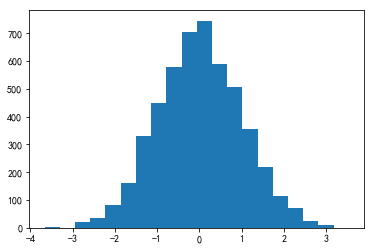python:绘制直方图(Histogram)
简介
本文主要总结如何绘制直方图,以及常用的使用场景。
什么是直方图:一个随机变量在各个取值区间有个概率分布,将其绘制出来:x轴为等间隔的取值区间(bins),y轴为该区间的频数(可归一化),即直方图。
接口Signature:
plt.hist(
x,
bins=None,
range=None,
density=None,
weights=None,
cumulative=False,
bottom=None,
histtype='bar',
align='mid',
orientation='vertical',
rwidth=None,
log=False,
color=None,
label=None,
stacked=False,
normed=None,
*,
data=None,
**kwargs,
)
Docstring:
Plot a histogram.
Compute and draw the histogram of *x*. The return value is a
tuple (*n*, *bins*, *patches*) or ([*n0*, *n1*, ...], *bins*,
[*patches0*, *patches1*,...]) if the input contains multiple
data.
实例1:正态分布的直方图
实例
生成一个正态分布数据x,然后绘制其直方图。
代码
mu,sigma = 0,1
x = np.random.normal(mu,sigma,size=5000)
n, bins,patches = plt.hist(x,bins=20)
print('n:',n)
print('bins:',bins)
print('patches:',patches)
分析
输入参数:
返回参数:
n:各区间(bin)的频数,即20个柱子的高度, bins:21个区间端点。查看数值可以看到第一个端点为min(x),最后一个端点为max(x)。 patches:表示20个柱子结果
n: [ 2. 1. 22. 36. 81. 161. 329. 448. 580. 703. 745. 590. 507. 354.
217. 115. 73. 25. 10. 1.]
bins: [-3.66700533 -3.30660994 -2.94621455 -2.58581916 -2.22542377 -1.86502838
-1.50463298 -1.14423759 -0.7838422 -0.42344681 -0.06305142 0.29734397
0.65773937 1.01813476 1.37853015 1.73892554 2.09932093 2.45971632
2.82011172 3.18050711 3.5409025 ]
patches:
 原创文章 57获赞 38访问量 32万+
关注
私信
展开阅读全文
原创文章 57获赞 38访问量 32万+
关注
私信
展开阅读全文
作者:kaever